and historical purposes, all rights reserved.
This page is copyright© by
This page may not be sold or distributed without
the expressed permission of the producer.
I have no connection with any camera company.
This camera manual library is for reference
and
historical purposes, all rights reserved.
This page is copyright© by ![]() ,
M. Butkus, NJ.
,
M. Butkus, NJ.
This page may not be sold or distributed without
the expressed permission of
the producer.
I have no connection with any camera company.
On-line camera manual library
If you find this manual useful,
how about a donation of
$3 to:
M. Butkus, 29 Lake Ave.,
High Bridge, NJ 08829-1701
and send your e-mail
address
so I can thank you.
Most other places would charge
you $7.50 for
a electronic copy
or $18.00 for a hard to read Xerox copy.
This will help me to continue to host this site,
buy new manuals, and pay their shipping costs.
It'll make you feel better, won't it ?
If you use Pay Pal, use the link below.
Use the above address for a check, M.O. or cash.
Back to main camera manual page
Click here for Capital Spot Meter PDF
version of manual
- better printing -

The Advantages of Model SP- I & SP 11 Spot Exposure Meter
 |
The Model SP- I and
SP-II Spot meters are professional exposure meters which measure an
extremely narrow angle of illumination. With 1° spot, the Spot meters
read a perfect exposure, enabling you to measure the key areas of the
subject you are photographing. The meter's viewfinder contains a small
circular mark, allowing you to pinpoint the exact area where a light
reading is desired. This is extremely valuable when metering unapproachable subjects or in situations where conventional light meters tend to give inaccurate readings (i.e. when photographing subjects in bright sunlight on a beach or against a snowy background). |
The Spot meters use an ultra-sensitive
Silicon Photo Diode (SPD) so that extremely low light exposure measurement
may be made.
The internal integrated circuits of
the meters are very reliable and will give many years of trouble free
service.
SPECIFICATION
 |
Angle of
incidence: 1° Angle of view: 15° (horizontal) 11° (vertical) Viewfinder: Diopter adjustment system pentaprism and condenser. Measuring system : Model SP- I : Needle indicator Model SP- II: Digital display Measuring distance range: 1.5m - oo 30cm-1.5m (with use of 43mm close up lens) Measuring EV range: Model SP- I : EV 2-18 (ASA 100) Model SP-II:EV 1-19.9 (ASA 100) Accuracy (at 0°C-40°C): ±0.2EV ASA/DIN range: ASA 6-6400/DIN 9-39 Aperture scale: f 1-f 45 Shutter speed: 1/2000 sec.-30 sec. Cine speed: 8. 16. 32. 64. 128. fps. Measuring method: Direct reading system. |
Battery: 1 pc. 9 volt dry battery
type (Eveready 522 or Mallory MN
1604 etc.)
Lens: 100mm f 2.8, fully coated.
Weight: Model SP-I:325 g (w/out
battery) Model SP-II: 315 g
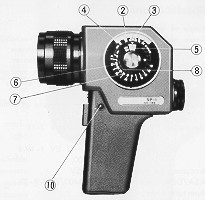 |
1. Object lens 2. EV scale 3. EV indicator mark 4. IRE scale 5. ASA/DIN window 6. Aperture scale 7. Shutter speed scale 8. Cine speed scale |
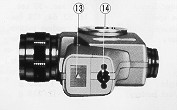 |
9. Operating switch 10. LED battery check (Model SP- I ) Hold button (Model SP-II) 11. Zero adjustment screw (Model SP- I ) 12. Sensing Spot 1 degree |
 |
13. Battery
compartment 14. Socket for wrist strap 15. Indicator needle (Model SP- I ) 16. LED display (Model SP-II) 17. Zero point (Model SP- I ) 18. EV figures 2-18 (at ASA 100) (Model SP- I ) |
Operating the Spot Meter
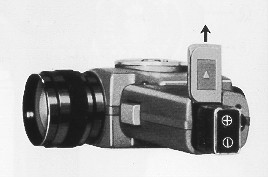 |
1. Loading Battery: Take off the cover of the battery case in the base of the handle and insert the battery. Make sure that the battery is loaded correctly according to the plus and minus indications inside the handle. Press down on the battery and slide the cover back into place. |
2. Battery Check: With the SP- I meter, the red LED lamp on the top left side of the handle grip will light when the battery is still on good condition. When using the SP-II meter, battery check is indicated directly in the view finder. There is no additional button to press. When the battery voltage starts dropping below usable range, a series of 8's will appear in the viewfinder. This is an indication that the battery should be replaced.
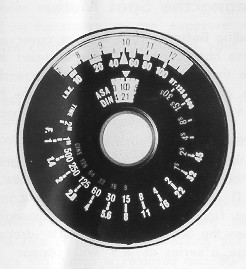 |
3. Setting ASA/DIN Film Speed: This is accomplished by turning the ASA/DIN scale to the required position indicated by the film speed you are using. |
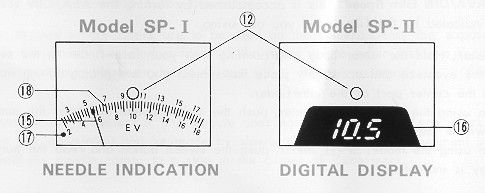
4. Using Meter: Hold the meter body grip pointing with your fore-finder to the switch button. View through the eyepiece and accurately place the subject you are photographing in the light sensing circle in the center part of the viewfinder.
a) When using the model SP- I meter, push the switch button and read the number at the position where the needle stays still.
b) When using the model SP-II meter, push the switch button and read the number that the LED display is indicating.
Now, transfer the number you have read in the
viewfinder to the EV scale. The correct combination of shutter speeds and
apertures will be indicated on the scales in the exposure dial of the left
side of the meter body. You can select a suitable combination according to
your photographic needs.
5. The Model SP-Q Digital Spot meter
employs a flickerless circuit, enabling measurements under fluorescent
light. A hold circuit enables the display to be frozen when the hold button
is depressed. Since the model SP-II Digital Spot meter indicates EV numbers
in the finder by means of a LED digital display, metering is easy with
little chance of error. In addition, metering a subject in the dark may also
be easily accomplished because of brilliant EV display in the finder.
The meter is very simple in use. You will notice, however, that some
metering situations will cause the digital display to vary from 0.1 to 0.2
EV numbers rapidly. This is where the hold button comes into use. The hold
button is located on the side of the meter. Pressing this button will freeze
the LED display at one numerical value. Once this button is released and the
trigger is released, however, LED display will disappear. This hold button
will allow you to hold the display for as long as you have this button
depressed.
6. Use of Filters: In case where filters
are to be used on the camera lens, the exposure reading should be made by
placing the filter in front of the meter's lens while taking a reading. This
gives you the correct exposure including any filter factors
automatically. (Filter size of 43mm)
7. Zero Adjustment for
SP- I Meter: If the needle does not return
to the Zero mark when the meter is not in use, adjustment can be made by
slowly turning the Zero adjustment screw to the right or left until the
needle comes to a stop in the center of Zero mark.
Methods of
measurement
The Spot
Exposure meter can be used in a number of ways. Among these methods are:
A) General measuring of half tone reading
method: This method is used to measure a half tone area or primary
interest area of an object. In this way, the photographer is assured of a
perfect exposure in relationship to his primary interest. For instance, if
you are photographing a model against a varied background, the background
would not be as important perhaps as the model's face. In order to get a
proper exposure, therefore, you would take an exposure reading off the
model's face. With this method of metering, your subject would be properly
exposed, regardless of the background. This method can be employed in
regards to such things as sports events, stage scenes or other high contrast
lighting situations.
B) Averaging method: This is a method to
measure an average light on a subject from a camera's location. With this
method you would measure a highlight, a medium area and a shadow area. With
these three readings, you would then take an average and expose your film
according to that average. If the difference between the highlight and
shadow area is within the range of reproducible contrast ratio of the film,
the results will be good. When, however, the difference exceeds this range,
the highlight area will be overexposed and the shadow area will be
underexposed. For black and white film, the difference is approximately
seven EV numbers. For ordinary color film, it is approximately five EV
numbers. If the difference in your scenes is greater than the reproducible
contrast ratio of the film, decide exposure value by measuring the primary
subject area as in the general measuring method.
The following two methods utilize the IRE scale:
C) Highlight or while level reading method:
This method was developed especially for color
television filming, and can be applied for movie making and still
photography. Reproducibility contrast ratio differs according to film type.
the ratio is 1 : 10 for block and white film and 1 :20 for television. The
Spot Exposure meter is provided with an IRE scale. On the IRE scale, the
reproducible image range lies between 100% and 10%. Proper exposure can be
achieved by measuring the highlight area of an object first and setting the
IRE scale on 100%. In this case, only the shadow areas to be reproduced on
the color film which occur above
the 10% indicator
will be reproduced. Other area having light value falling below the 10%
level will appear as unrelieved shadow. In such a case, additional
illumination must be supplied.
D) Shadow or black level reading method:
This method is just the opposite of the above. With this method you will be
measuring light value of a shadow area and set it on the IRE scale. At the
10% mark, the numerical value read is an adequate exposure value. In this
case, shadow detail to be reproduced on color film should occur between the
10% index and the 100% index or light level, Other areas having light
falling above this index will appear washed out. Accordingly, when using
additional illumination, it is necessary to reduce the light value to fall
within this 100% index or to increase the reflected light. This measuring
method is employed for bringing out detail of subjects with backlighting or
for fully reproducing shadow area at night.
Addendum : The Spot Exposure meter
comes complete with IRE scale which is designed especially for professional
photographers in the areas of television filming, movie making and
commercial photographs. This scale is based on the representative film
sensitivity index used by the Japanese private broadcasting unit and was
made specifically for television viewing, especially where a strict exposure
control is required.
The IRE makings also indicate
the respective divisions of the linear gray scale. The triangular index in
the center which is used on most general exposure meters is the standard
index and shows the average or optimum film exposure levels. The steps
between 60% and 80% on the IRE scale are generally specified as a light
level for facial tones. These will allow you to use your Spot exposure meter
more effectively.
The Spot exposure meter is
precision engineered to give the very best results for many years. The all
plastic body requires no special care, however, never drop or bump the meter
unnecessarily. It should be treated as the fine optical and electronic
instrument it is. Avoid storing the meter in places with extremes in
temperature or humidity. The lens should be kept clean and free of finger
prints. It is advisable to remove the battery from the meter if you are not
going to use it for some time.